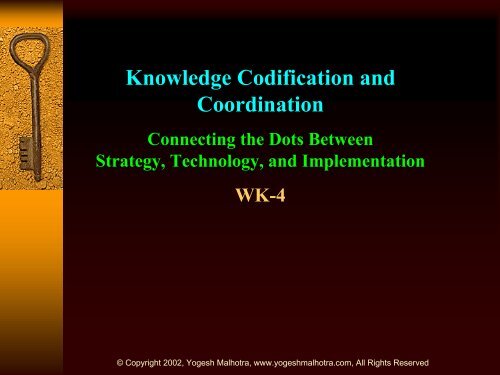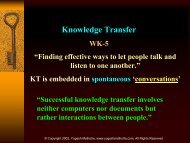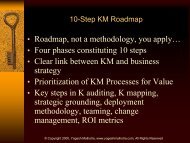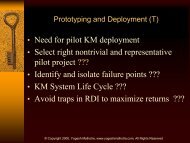Knowledge Codification and Coordination
Knowledge Codification and Coordination
Knowledge Codification and Coordination
You also want an ePaper? Increase the reach of your titles
YUMPU automatically turns print PDFs into web optimized ePapers that Google loves.
<strong>Knowledge</strong> <strong>Codification</strong> <strong>and</strong><br />
<strong>Coordination</strong><br />
Connecting the Dots Between<br />
Strategy, Technology, <strong>and</strong> Implementation<br />
WK-4<br />
© Copyright 2002, Yogesh Malhotra, www.yogeshmalhotra.com, All Rights Reserved
The Three Components of <strong>Knowledge</strong><br />
Management:<br />
• <strong>Knowledge</strong> generation.<br />
Includes all activities, which brings to light knowledge<br />
that is "new" to the individual, to the group, <strong>and</strong> to<br />
the organization.<br />
• <strong>Knowledge</strong> codification.<br />
Representation of knowledge so that it can be "reused"<br />
either by an individual or an organization.<br />
• <strong>Knowledge</strong> transfer.<br />
“Movement of knowledge from one location to<br />
another”.<br />
© Copyright 2002, Yogesh Malhotra, www.yogeshmalhotra.com, All Rights Reserved
<strong>Knowledge</strong> Generation<br />
• Involves intentional activities of an organization<br />
– To acquire new knowledge<br />
– To create new knowledge<br />
• Techniques include<br />
– Buy or rent<br />
– Can hire ‘expert’ firm or individuals<br />
– Support external research, grants, consortia<br />
• Value of intellectual capital, “fair price”<br />
– How to keep ‘purchased knowledge’ intact<br />
– Differences in culture make hard to assimilate<br />
© Copyright 2002, Yogesh Malhotra, www.yogeshmalhotra.com, All Rights Reserved
<strong>Knowledge</strong> Generation<br />
– Research <strong>and</strong> Development<br />
• long time to get financial return<br />
• value depends on how effectively applied<br />
– Xerox – the problem child PARC<br />
• most knowledge generation from synthesis<br />
– combination of K from different sources<br />
– in unique ways<br />
• so that new ideas emerge<br />
© Copyright 2002, Yogesh Malhotra, www.yogeshmalhotra.com, All Rights Reserved
<strong>Knowledge</strong> Generation<br />
– Shared Problem Solving<br />
• Leveraging diversity of people<br />
• different backgrounds<br />
• different cognitive styles<br />
• creative solutions<br />
• experience can constrain search for novel ideas<br />
– “Creative abrasion”<br />
• people with diverse background<br />
• but a shared vision<br />
• come together to solve problems<br />
© Copyright 2002, Yogesh Malhotra, www.yogeshmalhotra.com, All Rights Reserved
<strong>Knowledge</strong> Generation<br />
• Adaptation<br />
– External <strong>and</strong> internal threats<br />
– Force need to generate new knowledge<br />
– Apply existing resources in innovative <strong>and</strong><br />
creative ways to rethink workflows, processes,<br />
business models<br />
– When core capabilities can become core<br />
rigidities<br />
– When best practices become worst practices<br />
© Copyright 2002, Yogesh Malhotra, www.yogeshmalhotra.com, All Rights Reserved
<strong>Knowledge</strong> Generation<br />
– Communities of Practice<br />
• Groups of workers who share common interests<br />
<strong>and</strong> objectives, but are not necessarily employed<br />
in the same dept/location (or firm), <strong>and</strong> who<br />
occupy different organizational roles<br />
• Bonded by a common sense of purpose<br />
• Shared interests in knowledge sharing<br />
• Collaboration for new knowledge creation<br />
• Collaborate F2F, or, by phone, by email <strong>and</strong> via<br />
online Internet/web communities<br />
© Copyright 2002, Yogesh Malhotra, www.yogeshmalhotra.com, All Rights Reserved
<strong>Knowledge</strong> Capture & <strong>Codification</strong><br />
• <strong>Knowledge</strong> generation needs to be channeled<br />
– Continuous processes of classifying,<br />
categorizing, scanning, filtering, organizing <strong>and</strong><br />
packaging knowledge<br />
– <strong>Codification</strong> is representation of K to make<br />
it easily accessible <strong>and</strong> transferable<br />
• <strong>Knowledge</strong> accumulates <strong>and</strong> changes over time<br />
<strong>and</strong> so it is hard to “measure” in discrete units<br />
• Subjective <strong>and</strong> Context sensitivity – DKI - <br />
• Capturing <strong>and</strong> Coding go h<strong>and</strong> in h<strong>and</strong> – What<br />
is not coded is not accessible nor transferable<br />
– D&P’s 4 basic principles for K codification<br />
© Copyright 2002, Yogesh Malhotra, www.yogeshmalhotra.com, All Rights Reserved
Overview<br />
<strong>Knowledge</strong> <strong>Codification</strong> <strong>and</strong> <strong>Coordination</strong><br />
“Relevance is far more important than completeness”<br />
• Tacit, explicit, codified, rich, poor<br />
• Categorize, describe, map, model, simulate<br />
• Principles of K <strong>Codification</strong><br />
– Business goals, importance<br />
– Identify Existing K <strong>and</strong> goals<br />
– Usefulness <strong>and</strong> appropriateness<br />
– Medium for codification <strong>and</strong> distribution<br />
© Copyright 2002, Yogesh Malhotra, www.yogeshmalhotra.com, All Rights Reserved
Codifying <strong>and</strong> Mapping<br />
Overview<br />
“Tacit, complex knowledge, developed <strong>and</strong> internalized<br />
by the knower [over a long period of time], is almost<br />
impossible to reproduce in a document or database.”<br />
• Tacit <strong>Knowledge</strong> – hitting baseball<br />
• Tacit experience – how to K transfer<br />
• <strong>Knowledge</strong> map – people, documents <strong>and</strong><br />
databases<br />
• K map is an inventory – HR skills etc<br />
• K – a piece in every head<br />
• Six Degrees of Separation<br />
© Copyright 2002, Yogesh Malhotra, www.yogeshmalhotra.com, All Rights Reserved
Case Studies of K Management<br />
“… Clearly the value of the map was the quality <strong>and</strong><br />
depth of information more than the bells <strong>and</strong> whistles<br />
of a sophisticated storage <strong>and</strong> retrieval system.”<br />
• Time Researchers – K pools<br />
• Microsoft’s Competencies <strong>and</strong> Training<br />
• Technologies for Mapping <strong>Knowledge</strong><br />
– Groove, Lotus Notes / Raven / Websphere,<br />
Peoplesoft, SAP, Restrac, Resumix<br />
• 33 1/3 % Rule – IT vs. K Projects<br />
• Politics of Mapping <strong>Knowledge</strong><br />
– Map vs. Territory<br />
• Dynamic modeling of <strong>Knowledge</strong><br />
© Copyright 2002, Yogesh Malhotra, www.yogeshmalhotra.com, All Rights Reserved<br />
Overview
Case Studies of K Management<br />
• Weick’s sensemaking <strong>and</strong> aerial<br />
photographs – AI versus meaning making<br />
• Embedded knowledge – M&A<br />
• Deep Blue – how deep<br />
• Expert systems <strong>and</strong> AI – promises <strong>and</strong> hype<br />
• Monsanto’s KM A – Tangible Patents as K<br />
• K Taxonomies<br />
Overview<br />
© Copyright 2002, Yogesh Malhotra, www.yogeshmalhotra.com, All Rights Reserved
<strong>Codification</strong><br />
• What is the purpose of knowledge codification<br />
– To convert corporate knowledge into accessible <strong>and</strong><br />
applicable formats<br />
– 4 basic principles:<br />
•What business goals are to be served<br />
•What knowledge exists in what form to accomplish the<br />
goals<br />
• How can it best be codified for usefulness<br />
• What is the appropriate medium for codification <strong>and</strong><br />
distribution<br />
© Copyright 2002, Yogesh Malhotra, www.yogeshmalhotra.com, All Rights Reserved
<strong>Knowledge</strong> capture <strong>and</strong> codification<br />
• Capturing involves scanning, organizing <strong>and</strong><br />
packaging knowledge<br />
• <strong>Codification</strong> is representing knowledge in a<br />
manner that can easily be accessed<br />
• Principles of knowledge codification<br />
– Define strategic intent<br />
– Identify existing knowledge<br />
– Evaluate existing knowledge for usefulness<br />
– Determine medium for codification <strong>and</strong> distribution<br />
© Copyright 2002, Yogesh Malhotra, www.yogeshmalhotra.com, All Rights Reserved
<strong>Knowledge</strong> Capture & <strong>Codification</strong><br />
• Defining Strategic Intent<br />
– Determine the business problem to be solved <strong>and</strong> align<br />
knowledge to be captured with business objectives<br />
• Identify & Evaluate Existing <strong>Knowledge</strong><br />
– Very difficult to determine knowledge requirements.<br />
– Subjective process raising political, cultural <strong>and</strong><br />
strategic issues.<br />
– Different perspectives about content needs, <strong>and</strong> sources<br />
of “hard” <strong>and</strong> “soft” information (e.g., ideas, gossip <strong>and</strong><br />
opinion).<br />
© Copyright 2002, Yogesh Malhotra, www.yogeshmalhotra.com, All Rights Reserved
<strong>Knowledge</strong> Capture & <strong>Codification</strong><br />
• Determining Appropriate Media<br />
– Media choice will vary with richness <strong>and</strong> complexity<br />
of the knowledge captured<br />
– Scanning: involves a combination of electronic <strong>and</strong><br />
human approaches, <strong>and</strong> is usually the first step in<br />
capturing knowledge<br />
– Involves capturing info, filtering out redundant info,<br />
adding value via human input;<br />
– a team can be tasked, with scanning news wires,<br />
broadcasts, etc. <strong>and</strong> synthesizing info into a daily<br />
report<br />
© Copyright 2002, Yogesh Malhotra, www.yogeshmalhotra.com, All Rights Reserved
<strong>Knowledge</strong> Capture & <strong>Codification</strong><br />
• Determining Appropriate Media<br />
– Organizing: structures info in an accessible form<br />
– Too much structure can hide info from employees<br />
whose mental models don’t match chosen structure –<br />
Andersen’s KXchange<br />
– Four classifications<br />
• Process knowledge (e.g., best practices) that can<br />
increase efficiency<br />
• Factual knowledge easily documented but of little<br />
value unless synthesized <strong>and</strong> in context<br />
• Catalog knowledge shows where things are –<br />
People yellow pages<br />
• Cultural knowledge - cultural <strong>and</strong> political<br />
© Copyright 2002, Yogesh Malhotra, www.yogeshmalhotra.com, All Rights Reserved
<strong>Knowledge</strong> Capture & <strong>Codification</strong><br />
• Determining Appropriate Media<br />
• <strong>Knowledge</strong> Maps<br />
– Guides to where knowledge exists in an organization <strong>and</strong><br />
an inventory of knowledge assets available<br />
– Several schemes to map knowledge<br />
• Physical mapping (IS architecture)<br />
• Qualitative mapping – points to information by topic<br />
rather than location<br />
• Process mapping – uses a generalized model of how<br />
a business functions to map knowledge<br />
• Functional mapping – loosely based on org. chart<br />
• Conceptual mapping – organize around objects,<br />
such as customers – hard to do<br />
© Copyright 2002, Yogesh Malhotra, www.yogeshmalhotra.com, All Rights Reserved
<strong>Knowledge</strong> Capture & <strong>Codification</strong><br />
• Codifying Tacit <strong>Knowledge</strong><br />
• Narratives<br />
– A way to try to capture the tacit knowledge of<br />
experts<br />
– A story can communicate ideas <strong>and</strong> complex<br />
underst<strong>and</strong>ing of events<br />
– When knowledge is shared in a context shared<br />
by listeners it is more likely to be absorbed<br />
– Videotapes provide one way to share stories<br />
easily<br />
© Copyright 2002, Yogesh Malhotra, www.yogeshmalhotra.com, All Rights Reserved
<strong>Knowledge</strong> Transfer<br />
• Four different modes of knowledge<br />
conversion<br />
– Socialization<br />
– Externalization<br />
– Combination<br />
– Internalization<br />
© Copyright 2002, Yogesh Malhotra, www.yogeshmalhotra.com, All Rights Reserved
Nonaka <strong>and</strong> Takeuchi (1995)<br />
Tacit to Tacit – Socialization<br />
Tacit to Explicit – Externalization<br />
Explicit to Explicit – Combination<br />
Explicit to Tacit - Internalization<br />
FROM<br />
Tacit<br />
Explicit<br />
Tacit<br />
Socialization<br />
Internalization<br />
Explicit<br />
Externalization<br />
Combination<br />
TO<br />
© Copyright 2002, Yogesh Malhotra, www.yogeshmalhotra.com, All Rights Reserved
<strong>Codification</strong><br />
• Gives structure & permanence to<br />
otherwise nebulous forms of knowledge<br />
– Pros <strong>and</strong> Cons<br />
– Distinctiveness & its value<br />
– Flexibility & adaptability to change – ‘Static’<br />
© Copyright 2002, Yogesh Malhotra, www.yogeshmalhotra.com, All Rights Reserved
Pros <strong>and</strong> Cons of <strong>Codification</strong><br />
• The more codifiable <strong>and</strong> teachable a capability is,<br />
the higher the risk of rapid transfer<br />
• High level of “Technological competition” <strong>and</strong><br />
fear of losing tech edge speeds transfer of<br />
capabilities.<br />
• Characteristics of the manufacturing capability do<br />
not affect hazard rate.<br />
• Imitation <strong>and</strong> transfer are not identical<br />
phenomena<br />
• Key Employee turnover is significantly associated<br />
with faster imitation time<br />
© Copyright 2002, Yogesh Malhotra, www.yogeshmalhotra.com, All Rights Reserved
<strong>Knowledge</strong> Generation <strong>and</strong> <strong>Codification</strong><br />
• <strong>Knowledge</strong> generation<br />
• <strong>Knowledge</strong> codification<br />
• <strong>Knowledge</strong> transfer - spirals<br />
• Tools<br />
– Data management tools- data warehouses, data search<br />
engines, data modeling, visualization<br />
– Information management tools - automated information<br />
search <strong>and</strong> retrieval agents, decision support<br />
technologies, executive information systems, document<br />
management technologies<br />
– <strong>Knowledge</strong> management<br />
© Copyright 2002, Yogesh Malhotra, www.yogeshmalhotra.com, All Rights Reserved








